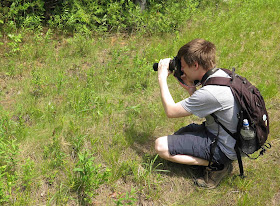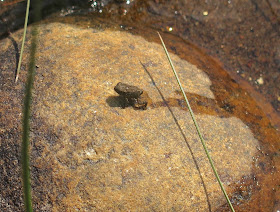Out on a Wet Meadow
Aaarrgh!!! It wasn't the best of days to go orchid hunting: temps in the upper 90s and the humidity up there, too. But if it's time for the orchids to bloom, it's time to go looking for them, whatever the weather. My friend Dan is working on a book combining paintings and photos of New York's native orchids, and since he still has a few left to find, some of his friends are showing him where they might be growing. So that's why Dan and I headed up toward Thirteenth Lake on Saturday, where I promised Dan we would find Tubercled Orchids (Platanthera flava) by the hundreds in a wet meadow, near an old garnet mine. And so we did. Unfortunately, most of them were still in tight bud, but Dan found a few that had a few florets open.
(I hope he got a better photo of them than I did!)
The site where we found all these orchids was once a pond that served as a water supply for an adjoining garnet mine. The mining operation is long closed and the dam that held the water back to make this pond has long ago collapsed, leaving an open wet meadow filled with Chairmaker's Rush (Schoenoplectus pungens) and many other grasses and sedges that thrive in this habitat.
Among the most abundant of these graminoids is Alpine Bulrush (Trichophorum alpinum) with its flowing cottony bristles. It always make me think of an army of tiny trolls assembled in the grass.
White Beak-sedge (Rynchospora alba) is another abundant denizen of this meadow, its tiny white beak-shaped flowers a beautiful sight among its dark-green grass-like leaves.
Aside from the Tubercled Orchids, about the only wildflowers we found blooming this day were patches of Robbins Ragwort (Packera schweinitziana) holding its bright-yellow flower clusters well above the other plants.
Although the flowers of Robbins Ragwort appear very similar to other ragwort species, its later bloom time and much longer basal leaves are distinctive features that help me to identify it.
I'm sure that Dan must have been at least a little disappointed not to have found the Tubercled Orchids in more photogenic bloom, but at least now he knows how to get to where they grow in such abundance, if he wants to come back for better photos. We didn't linger much longer at this site, for there was another site where we hoped to find another orchid, the Pad-leaved Orchid (Platanthera macrophylla), and that site happened to be on our way home.
On the Trail Through the Woods
At least it felt a bit cooler in the deep, dark shade of the woodland trail where I had seen the Pad-leaved Orchids a few years before, thanks to being led there myself by my good friends Evelyn Greene and Bob Duncan. Bob had given Dan some very specific directions to where the orchids were likely to grow, and sure enough, we found them! Quite a few of them, in fact, and all of them looking very healthy, with many buds about to bloom. Sigh! Too early, once again! But there was no doubt about the identity of these orchids, even though they were not yet blooming.
For one thing, the florets' spurs were already evident, and measurable at well over 28 millimeters. There is another orchid, Platanthera orbiculata, that looks almost identical to P. macrophylla, except that its flower spurs are less than 28 millimeters long. Ours were approaching 40 millimenters: a clinching detail!
Another common name for both of the orchids I mentioned is Large-leaved Orchid, and this photo shows how big those leaves are, and how flat they lie on the ground.
One of the other treasures we found along this woodland trail was the White Wood Sorrel (Oxalis montana), holding its pretty, pink-striped blooms above its clover-like leaves.
There aren't many flowers that bloom in such dense shade, and the White Wood Sorrel is certainly one of the most beautiful ones that do.
Here was an extra gift from the nature gods for enduring the sweltering heat of this day outdoors: a lovely White Admiral Butterfly, spreading its beautiful wings on a bush near where we had parked our cars. A close look reveals some red spots on the wings, for the White Admiral is the same species as the Red-spotted Purple Butterfly (Limenitis arthemis), even though it looks quite different, especially from a distance.
Out on the Hudson Shore
We made one more stop as we drove toward home, and that was the marble-bouldered shore of the Hudson River just north of Warrensburg. This is an area of riverbank known to be home to many unusual plants, and Dan remembered finding one more of the orchids on his wanted list growing out here.
We never did find that orchid -- the Shining Ladies' Tresses (Spiranthes lucida) -- but we did enjoy seeing the beautiful purple blooms of Harebell (Campanula rotundifolia), looking fresh and lovely despite the wilting heat and strong sun pounding down on the rocks where they grew.
Rock Sandwort was also looking completely unfazed by the daunting heat, its starry blooms set among hair-fine leaves, spreading across the marble outcroppings close to where the woods began. I first learned the scientific name of this lovely flower as Arenaria stricta, but that got changed to Minuartia michauxii a few years ago. Maybe you might still find Rock Sandwort listed under that second name, but now the New York Plant Atlas has listed it by another new name once again: Sabulina michauxii var. michauxii. Forgive me, botanical purists, but I think I will just call it Rock Sandwort from here on out.
I was delighted to find this tiny buttercup called Creeping Spearwort growing close to the water in damp sand. It's not a rare plant, but I cannot count on finding it in the same place every year, and I think it's adorable. Now, it, too, has a new scientific name. It used to be called Ranunculus reptans, but its new name now is Ranunculus flammula var. reptans. But it will always be Creeping Spearwort to me.
There were hundreds of these tiny toads hopping all over the sand down close to the water. Talk about adorable! They must have only recently emerged from their tadpole stage. I wondered how they didn't get cooked by the burning sun when they hopped out onto the shoreline rocks. But of course, they just hopped back in the water to cool off. Something I was wishing I could do. I was actually starting to feel kind of nauseated by the heat, and my head was starting to throb. Time to hurry back to my air-conditioned car!
Luckily, a shaded trail lay between the open shore and the parking lot. It was still sweltering under the trees, but somehow the deep-green leaves of the Partridgeberry masses covering the forest floor gave off the impression of coolness, and that helped!




















No comments:
Post a Comment